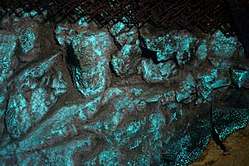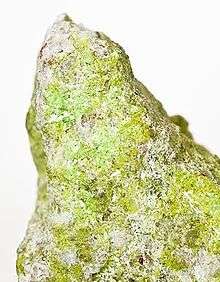Schröckingerite
Schröckingerite is a radioactive yellow uranium-containing carbonate mineral, hydrated sodium calcium uranyl sulfate carbonate fluoride.[2][3][4] Schröckingerite crystallizes in the orthorhombic system, occurring as globular clusters, and fluoresces yellow-green under ultraviolet light.

Schröckingerite in UV-light
| Schröckingerite | |
|---|---|
 | |
| General | |
| Category | Carbonate minerals |
| Formula (repeating unit) | NaCa3(UO2)[F|(CO3)3(SO4)]·10(H2O)[1] |
| Strunz classification | 5.EG.05 |
| Crystal system | Triclinic |
| Crystal class | Pinacoidal (1) (same H-M symbol) |
| Space group | P1 |
| Identification | |
| Other characteristics | |
Schröckingerite was first described in 1783 from an occurrence in Jáchymov, Bohemia, Czech Republic, and named for its discoverer, Julius Freiherr Schrockinger von Neudenberg (1814–1882).[2][4]
References
- Sometimes presented as: (NaCa3(UO2)(CO3)3(SO4)F·10(H2O)
- http://www.webmineral.com/data/Schrockingerite.shtml Webmineral
- http://www.mindat.org/min-3584.html Mindat
- "Schrockingerite". OpticalMineralogy.com. Retrieved 15 December 2011.
This article is issued from Wikipedia. The text is licensed under Creative Commons - Attribution - Sharealike. Additional terms may apply for the media files.